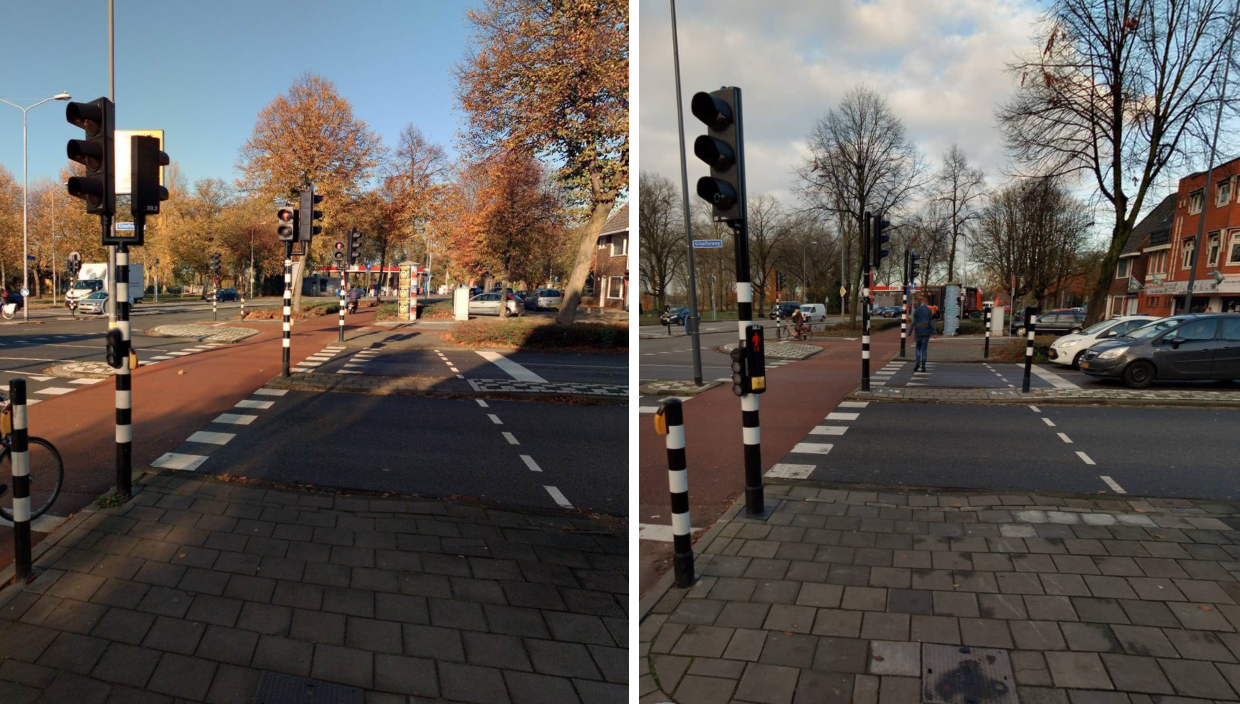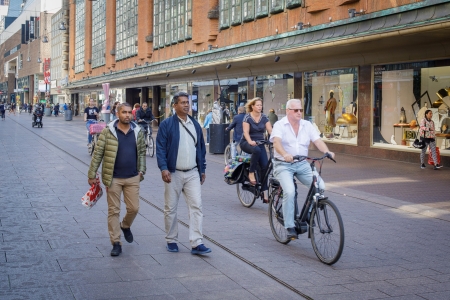If a zebra crossing or a signalised crossing has been designed according to the guidelines, it is safer for pedestrians to cross distributor roads at those crossings and not elsewhere [18] [19]. A signalised crossing is safest [18] [20]. Mere zebra marking do not have enough effect; because of the shallow angle of a driver’s glance at the road surface, road markings are hard to see from a distance [21].
Signalised crossings
Traffic lights can achieve time separation of pedestrians (and cyclists) from heavy motorised traffic. Conflict-free traffic lights with exclusive signal phasing are safest [11] [22]. Concurrent signal phasing may occur, for example, when the lights are green not only for vehicles taking a left or right turn, but also for pedestrians (and/or cyclists) crossing the street the vehicles turn into. At intersections where a lot of older people tend to cross, they should be permitted enough time to cross the road; after all, their walking speed is lower. Coffin and Morrall [23] advise 1.0 m/s (3.6 km/h) as a starting point. In comparison: the Dutch Traffic light regulation prescribes basing calculations on a walking speed of 1.2 m/s [24].
In the Netherlands, the pedestrian traffic light is usually mounted at the end of the crossing but, following its position in the city of Maastricht, a position at the beginning of the crossing similar to that for other traffic is also possible (see Figure 3). Since 2019, this position has been allowed following the new article 79a in the Traffic light regulation. In the United Kingdom this position has been applied for several decades under the name of ‘Puffin crossing’ (Pedestrian User Friendly Intelligent crossing [25] ) and has improved road safety for pedestrians [26] [27]. Sensors follow pedestrians at crossings to determine the time they need to cross, so that driver traffic lights turn green sooner when pedestrians cross faster, and later when pedestrians cross more slowly [25]. A Puffin crossing causes less confusion about the green phase of the traffic light for one’s own lane (prevents ‘green lure’) and is more visible for visually impaired road users [28]. Possible doubt about the moment when drivers start driving used to be mentioned as an objection, but SWOV research showed that a slight majority of pedestrians prefer pedestrian lights at the beginning of the crossing, e.g., because visually impaired road users are better able to see the lights then [29].

 Figure 6. Above: pedestrian light at the beginning of the crossing, the ‘Maastricht position’ (Photograph: Eric Greweldinger). Below: Before and after installing pedestrian lights at the ‘Maastricht position’ in the city of Den Bosch (Photograph: Cyclomedia).
Figure 6. Above: pedestrian light at the beginning of the crossing, the ‘Maastricht position’ (Photograph: Eric Greweldinger). Below: Before and after installing pedestrian lights at the ‘Maastricht position’ in the city of Den Bosch (Photograph: Cyclomedia).
Research into the safety effect of zebra markings
It is hard to draw valid conclusions about the effect of zebra markings. There is little high-quality research, and comparisons between studies from different countries are hard because of judicial and contextual differences. A lot of studies do not take the number of pedestrians and motor vehicles at a crossing into account, nor design characteristics such as physical speed reduction measures and conspicuity, and zebra markings are sometimes included in the broader category of ‘marked crosswalks’ [18] [19]. For the situation in the Netherlands, an older SWOV study concludes that, compared to road sections without crossings, it is safer to cross at a zebra crossing and safest at a signalised crossing [20]. Existing research may lead to the cautious conclusion that zebra markings alone (at a crossing length of two lanes at most) have little effect on road safety, but zebra markings combined with measures such as signage and physical speed reduction could have a positive effect [9] [18] [19] [20] [30].
